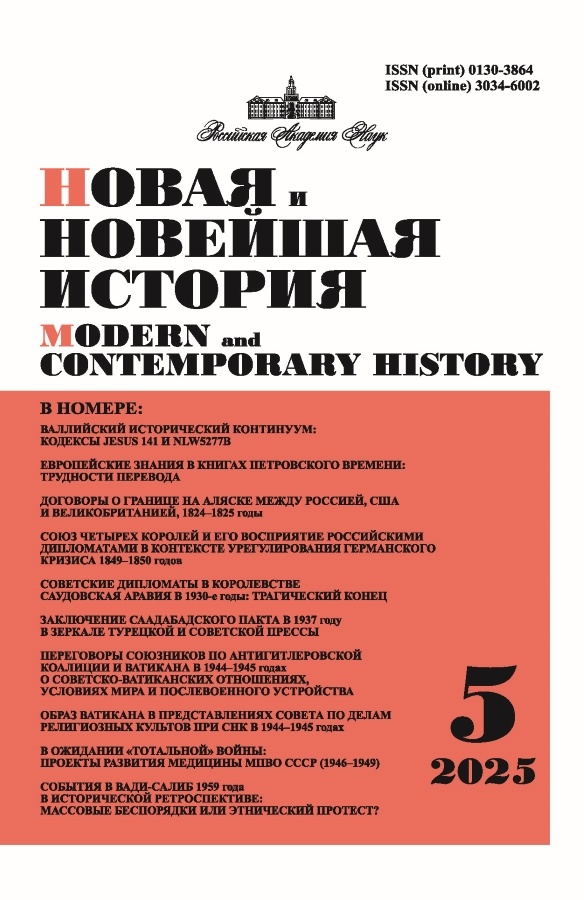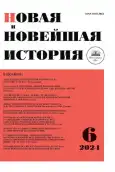История одного пророчества: дамасская «Легенда об астраханских старцах» в контексте арабо-российских контактов XVIII века
- Авторы: Кобищанов Т.Ю.1
-
Учреждения:
- Московский государственный университет им. М.В. Ломоносова
- Выпуск: № 6 (2024)
- Страницы: 76-91
- Раздел: Новое время
- URL: https://gynecology.orscience.ru/0130-3864/article/view/671419
- DOI: https://doi.org/10.31857/S0130386424060062
- ID: 671419
Цитировать
Полный текст
Аннотация
Во второй половине XVIII в. между арабским миром и Россией в дополнение к существовавшим церковным связям возникли первые дипломатические и военно-политические контакты. Принято считать, что религиозные сношения и взаимодействие по светской линии являлись параллельными, слабо пересекавшимися друг с другом процессами. Недавно обнаруженные в российских архивах документы опровергают эту теорию. Тем не менее остается не до конца ясным ход мыслей, который толкнул в начале 1770-х годов ряд ближневосточных правителей и их арабо-христианских советников к ставшему для них фатальным военному союзу с Россией. В поисках возможного ответа автор статьи обращается к документу, который ранее не являлся предметом детального изучения историков: «Легенде об астраханских старцах», пророчеству, зафиксированному дамасским хронистом Михаилом Брайком (ум. 1781 г.). В статье исследуется текст предсказания, якобы пришедшего в 1758 г. в Иерусалим из российской Астрахани; анализируются предпосылки его появления и социальный фон, сделавший это откровение актуальным для жителей Сирии; выявляется его предполагаемый автор, демонстрируются использованные им литературные и манипулятивно-психологические приемы; препарируется внутренняя структура документа; предлагается гипотеза о влиянии пророчества на последовавшие политические решения ближневосточных правителей.
Ключевые слова
Полный текст
Об авторах
Тарас Юрьевич Кобищанов
Московский государственный университет им. М.В. Ломоносова
Автор, ответственный за переписку.
Email: kobischanov@mail.ru
ORCID iD: 0000-0001-8165-0897
Scopus Author ID: 57220932499
ResearcherId: AAV-6437-2021
кандидат исторических наук, доцент кафедры истории стран Ближнего и Среднего Востока Института стран Азии и Африки
Россия, МоскваСписок литературы
- Аганин А.Р. Племена Сирийской пустыни и долины Евфрата. М., 2018.
- ал-Будайри Шихабаддин Ахмад. Ежедневные события Дамаска аш-Шам с 1154 по 1176 год (1741–1763). М., 2021.
- Иогансон Л.И. О связи сейсмической активизации в приатлантической Европе и Америке с землетрясениями 1 ноября 1755 и 31 марта 1761 годов // Необычные и экстремальные явления XVIII века. Сборник научных трудов. Вып. 3 / сост. С.Ю. Нечаев. СПб., 2020. С. 111–129.
- Кириллина С.А. Очарованные странники. Арабо-османский мир глазами российских паломников XVI–XVIII столетий. М., 2010.
- Кобищанов Т.Ю. Крест над Бейрутом: российская экспедиция в Восточное Средиземноморье 1769–1774 гг. в восприятии сирийских современников // Вестник Московского университета. Сер. 13. Востоковедение. 2009. № 1. С. 3–22; № 2. С. 3–20.
- Кобищанов Т. Ю. Христиане Ближнего Востока и роль их «заговора» в Архипелагской экспедиции российского флота 1769–1774 гг. // Вестник Православного Свято-Тихоновского гуманитарного университета. Серия III. Филология. 2018. № 57. С. 47–57.
- Кулаков В.О. Грузинский царь Вахтанг VI в Астрахани: страницы истории тайной дипломатии России (первая треть XVIII в.) // Новый исторический вестник. 2009. № 2 (20). С. 99–105.
- Луховицкий Л.В. Кирилл V // Православная энциклопедия. Т. 34. М., 2014. С. 561–562.
- Мейер М.С. Османская империя в XVIII веке: черты структурного кризиса. М., 1991.
- Панченко К.А. Иаков Патмосский // Православная Энциклопедия. Т. 20. М., 2009. С. 547–548.
- Панченко К.А. Иерусалимский Патриарх Парфений (1737–1766 гг.) и Россия: непонятый союзник // Вестник церковной истории. 2010. № 3–4 (19–20). С. 271–285.
- Панченко К.А. Митрополит ‘Иса и первое арабское описание Московии (1586 г.) // Панченко К.А. Православные арабы: путь через века. М., 2013. С. 280–295.
- Панченко К.А. Михаил Брейк // Православная Энциклопедия. Т. 45. М., 2017. С. 703–704.
- Панченко К.А. Сильвестр // Православная Энциклопедия. Т. 63. М., 2021. С. 351–355.
- Ряжев А.С. Католические миссионеры на южных российских окраинах в первой половине XVIII в. (по документам Архива внешней политики Российской империи) // Oriental Studies. №14 (3), 2021. С. 449–458.
- Смилянская Е.Б., Смилянская И.М., Велижев М.Б. Россия в Средиземноморье. Архипелагская экспедиция Екатерины Великой. М., 2011.
- Фейган Б. Малый ледниковый период. Как климат изменил историю, 1300–1850. М., 2022.
- Bualuan Hayat El-Eid. Christians and Muslims under Ottoman Rule in the Writings of Mikhail Breik (d. 1782) and Constantin François Chasseboeuf, Volney (1757–1820). Saarbrücken, 2016.
- Bualuan Hayat El Eid. Lebanese Historical Thought in the Eighteenth Century. New-York; London, 2023.
- Çolak Hasan. Amsterdam’s Greek merchants: protégés of the Dutch, beneficiaries of the Russians, subjects of the Ottomans and supporters of Greece // Byzantine and Modern Greek Studies. 2018. № 42 (1). Р. 115–133.
- Esbroeck M. van. Peter the Iberian and Dionysius the Areopagite: Honigmann’s Thesis Revisited // Orientalia Christiana Periodica. 1993. Vol. 59. Р. 217–227.
- Kemp P. Mosul and Mosuli Historians of the Jalīlī era (1726–1834): Pembroke College Degree of D. Phil. Michaelmas, 1979.
- Sajdi D. The Barber of Damascus. Nouveau Literacy in the Eighteenth-Century Ottoman Levant. Stanford, 2013.
- Walbiner C.-M. The Split of the Greek Orthodox Patriarchate of Antioch (1724) and the Emergence of a New Identity in Bilâd al-Shâm as Reflected by Some Melkite Historians of the 18th and Early 20th Century // Chronos. Balamand (Tripoli, Lebanon). 2003. № 7. P. 9–36.
Дополнительные файлы








